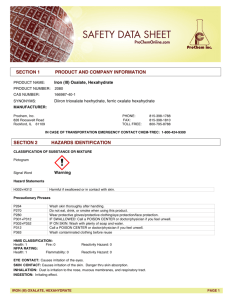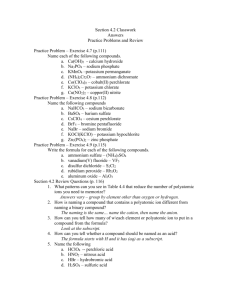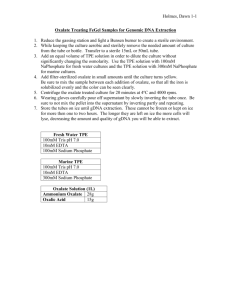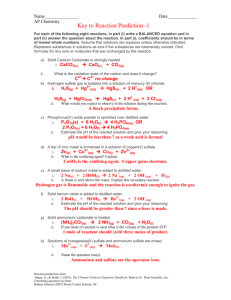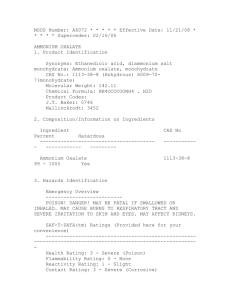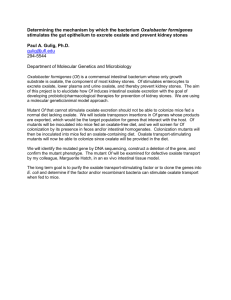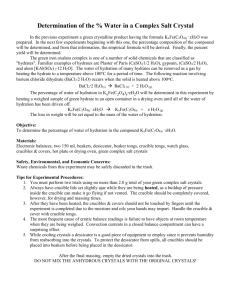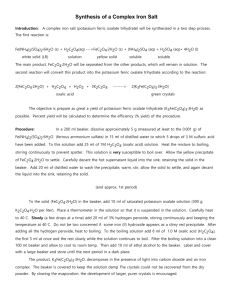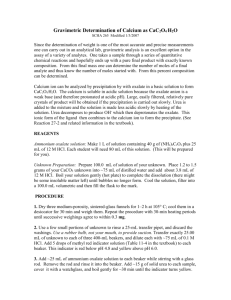Potassium Ferric Oxalate
advertisement
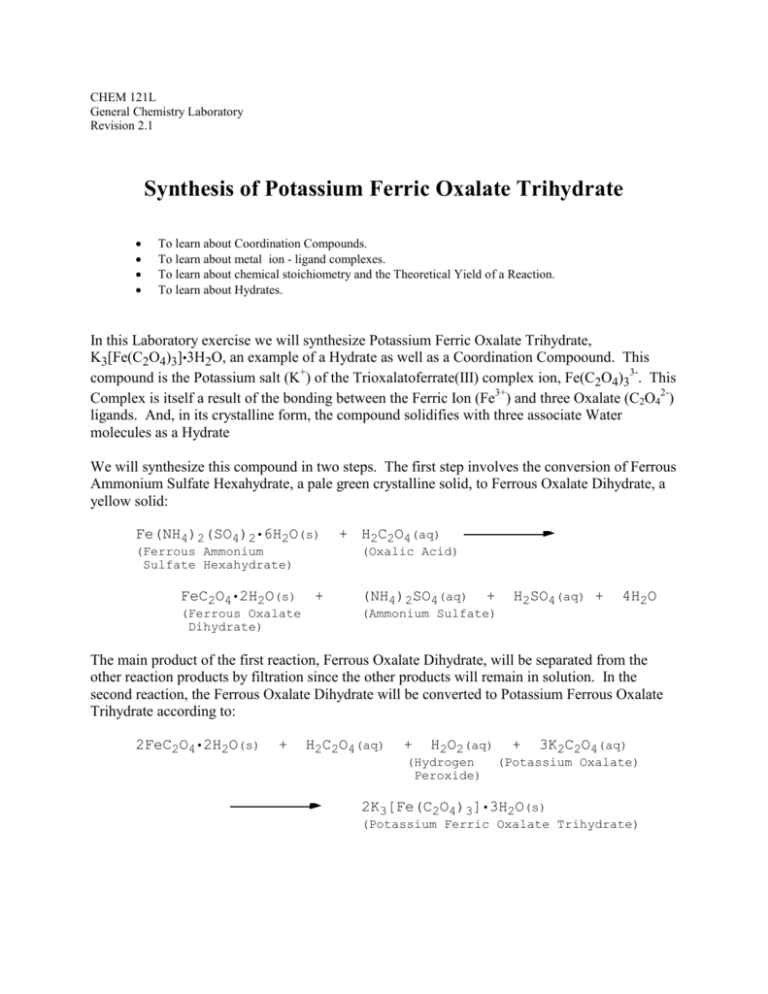
CHEM 121L General Chemistry Laboratory Revision 2.1 Synthesis of Potassium Ferric Oxalate Trihydrate To learn about Coordination Compounds. To learn about metal ion - ligand complexes. To learn about chemical stoichiometry and the Theoretical Yield of a Reaction. To learn about Hydrates. In this Laboratory exercise we will synthesize Potassium Ferric Oxalate Trihydrate, K3[Fe(C2O4)3]•3H2O, an example of a Hydrate as well as a Coordination Compoound. This compound is the Potassium salt (K+) of the Trioxalatoferrate(III) complex ion, Fe(C2O4)33-. This Complex is itself a result of the bonding between the Ferric Ion (Fe3+) and three Oxalate (C2O42-) ligands. And, in its crystalline form, the compound solidifies with three associate Water molecules as a Hydrate We will synthesize this compound in two steps. The first step involves the conversion of Ferrous Ammonium Sulfate Hexahydrate, a pale green crystalline solid, to Ferrous Oxalate Dihydrate, a yellow solid: Fe(NH4)2(SO4)2•6H2O(s) (Ferrous Ammonium Sulfate Hexahydrate) FeC2O4•2H2O(s) (Ferrous Oxalate Dihydrate) + H2C2O4(aq) (Oxalic Acid) + (NH4)2SO4(aq) + H2SO4(aq) + 4H2O (Ammonium Sulfate) The main product of the first reaction, Ferrous Oxalate Dihydrate, will be separated from the other reaction products by filtration since the other products will remain in solution. In the second reaction, the Ferrous Oxalate Dihydrate will be converted to Potassium Ferrous Oxalate Trihydrate according to: 2FeC2O4•2H2O(s) + H2C2O4(aq) + H2O2(aq) + 3K2C2O4(aq) (Hydrogen (Potassium Oxalate) Peroxide) 2K3[Fe(C2O4)3]•3H2O(s) (Potassium Ferric Oxalate Trihydrate) Page |2 As mentioned above our target compound is an example of a coordination compound. Coordination Compounds are substances that contain a Complex Ion, a species consisting of a central metal atom, a transition metal or Main Group metal, bound to several Ligands. An example is Hexaammine Cobalt (III) Chloride, [Co(NH3)6]Cl3, which contains the complex ion Co(NH3)63+. This salt, just like simpler salts (e.g., NaCl, CaF2, etc.) involves Ionic Bonding between the complex ion and the three chloride, Cl-, ions. Further, like many simpler salts, it is soluble in water: [Co(NH3)6]Cl3(s) Co(NH3)63+(aq) + 3 Cl-(aq) In this example, the complex ion contains the Co3+ transition metal ion and six NH3 ligands. Each ligand forms a single bond to the central metal ion, resulting in an octahedrally bound complex: The number of bonds formed between the metal center of the Complex and its ligands is referred to as the Coordination Number. In the above example, the Coordination Number is six. The coordination number determines the geometry of these complexes. Typical geometries are: Coordination Number 2 4 6 Geometry Linear Square Planar or Tetrahedral Octahedral In the above case the NH3 ligand is monodentate, meaning that it forms a single bond with the metal ion. Ligands can be multidentate, forming multiple bonds to the metal center. The Oxalate Ion (C2O42-) is an example of a bidentate ligand; having two bonding points for the metal ion: Page |3 Our Ferric Oxalate product is a specialty chemical in the sense that it has only a few commercial uses. Most abundantly, it is used in Platinum/Palladium photographic printing. An aqueous solution of the potassium ferric oxalate is first converted to the acidic hydrogen ferric oxalate: K3[Fe(C2O4)3](aq) + 3 H+(aq) H3[Fe(C2O4)3](aq) + 3 K+(aq) The resulting Acid is then used as a sensitizer in developing a photographic print. Another, unrelated, use is as a desensitizer in patients that exhibit a hypersensitive dental condition. Page |4 Pre-Lab Questions 1. What is the Theoretical Yield of the synthesis of Potassium Ferric Oxalate Trihydrate if we start with 5.3242g of the starting material, Ferrous Ammonium Sulfate Hexahydrate? Note: The overall stoichiometry for this synthesis is: Fe(NH4)2(SO4)2•6H2O K3[Fe(C2O4)3]•3H2O 2. Given the above amount of Ferrous Ammonium Sulfate Hexahydrate, what is the minimum amount of Oxalic Acid (H2C2O4) required in the first step on our synthesis? 3. Again, assuming we start with the above amount of Ammonium Sulfate Hexahydrate, what is the minimum amount of Hydrogen Peroxide (H2O2) required in the second step of the synthesis? Given the solution of Hydrogen Peroxide we will be working with is 3% by weight, what is the mass of this solution required to carry out our synthesis? Page |5 Procedure Note: If the Addendum exercise is being performed, do step #1 of the addendum procedure before starting the synthesis of Alum. 1. In your 200mL beaker, dissolve approximately 5g (measured on the analytical balance), of Ferrous ammonium sulfate hexahydrate in 15mL of distilled water to which 5 drops of 3M H2SO4 have been added. 2. To this solution add 25 mL of 1M H2C2O4 solution. Heat the mixture to boiling, stirring continuously to prevent spattering. This solution is very susceptible to boil over, so you must not leave it unattended. 3. Allow the yellow precipitate of Ferrous oxalate dihydrate to settle. Using large beaker tongs, carefully decant the hot supernatant liquid into the sink, retaining the solid in the beaker. Add 20mL of distilled water to wash the precipitate, warm, stir, allow the solid to settle, and again decant the liquid into the sink, retaining the solid. 4. To the solid in the beaker, add 10mL of saturated K2C2O4 solution. 5. Support your thermometer using a ring stand, a one-holed stopper, and a clamp, and place the thermometer in the solution. Carefully heat the solution to 40oC. 6. Obtain 20mL 3% H2O2 in your 25mL graduate, and add the 20mL of H2O2 very slowly, a few drops at a time, stirring continuously and keeping the temperature near 40oC. Do not become too concerned if some Fe(OH)3 (slimy red precipitate) appears. After adding all the H2O2, heat the solution to boiling. 7. To the boiling solution, add 8mL of 1M H2C2O4 - the first 5mL all at once and the last 3mL very slowly-keeping the solution boiling. 8. Set up a funnel with filter paper on a ring stand and filter the boiling solution into a clean 100mL beaker. Allow to cool to room temperature, and then add 10mL ethyl alcohol to the beaker. Label the beaker with your name, cover it with your largest beaker, which has been wrapped in Aluminum foil, and place it in your laboratory drawer until the next laboratory period. Steps 9, 10 & 11 Performed During Next Laboratory 9. At the beginning of the next laboratory session, assemble a Buchner funnel set-up. Using your stirring rod equipped with a rubber policeman, transfer the crystals of Potassium ferric oxalate trihydrate from the beaker to the filter paper in the funnel. 10. When the crystals are free of solution, remove the filter paper and spread the crystals out so they can dry. Page |6 11. Obtain the mass of the crystals. 12. Obtain a 3 dram vial and submit a sample of your product. Label the vial with the following information: Name(s) Name of Compound Formula of Compound Date Weight of Product Page |7 Data Analysis & Conclusions 1. Calculate the Theoretical Yield of Potassium Ferric Oxalate Trihydrate. 2. Calculate the Percentage Yield of Potassium Ferric Oxalate Trihydrate. 3. Comment on your Sources of Loss. Page |8 Post Lab Questions 1. What is the charge on the Iron Ion in the starting material, Ferrous Ammonium Sulfate Hexahydrate? Similarly, what is the charge on the Iron Ion in the product compound, Potassium Ferric Oxalate Trihydrate? How about for the reaction intermediate FeC2O4•2H2O? 2. In this laboratory you have used two different types of filtration. One is Gravity Filtration. The other is filtration using a Buchner Funnel. What is the principle difference in the purpose of these types of filtration? 3. Suppose I expect a Loss of 40%, how much Ferrous Ammonium Sulfate Hexahydrate must I start with in order to obtain 100g of Potassium Ferric Oxalate Trihydrate? 4. Ammonium Sulfate ((NH4)2SO4), Sulfuric Acid (H2SO4) and Water (H2O) are all byproducts of the first reaction in our synthesis. How much (mass) of each are produced when starting 5.00g of Ferrous Ammonium Sulfate Hexahydrate? 4. What ions are formed when each of the following Water Soluble coordination compounds dissolves in Water: a) [Cr(NH3)4Cl2]Cl b) K2[PtCl4] c) [Co(en)3](NO3)3 Page |9 Addendum Properties of Hydrates It should be noted our product crystallizes as a Hydrate. Hydrates are salts that crystallize from a water solution and contain weakly bound water molecules. For example, Ferric Chloride, FeCl3, crystallizes with six water molecules weakly bound to the Fe3+ ion in an octahedral arrangement: This is denoted as FeCl3•6H2O and is referred to as Ferric Chloride Hexahydrate. Note the unusual method for writing the chemical formula of this compound. A hydrate is an addition compound; a compound that contains two or more simpler compounds. In the above example, the simpler compounds are FeCl3 and H2O, which combine in a ratio of six waters to every formula unit of Ferric Chloride. This is a weak chemical combination between the water and the salt. As such, the combination is denoted with a "dot." However, the water molecules are as much a part of the compound as the other atoms. As another example, Cupric Sulfate Pentahydrate, CuSO4•5H2O, has four water molecules loosely associated with the Cu2+ ion and one which bridges the SO42- ions on adjacent formula units of CuSO4. The bonding of the water to the Cu2+ is depicted in the figure (left) below. The bridging water molecule is depicted in the figure (right) below. [Note: You may want to have a pint of Beer, a glass of Wine (okay, maybe two), or some other libation before wading through this diagram and pondering how the atoms are bound together.] P a g e | 10 Crystal Structure of Cupric Sulfate Pentahydrate Inorganic Chemistry: Principles of Structure and Reactivity James E. Huheey, Ellen A. Keiter, Richard L. Keiter When a hydrate is heated, the loosely held water is driven off as water vapor, leaving an anhydrous salt behind. For example: CuSO4•5H2O(s) CuSO4(s) + 5 H2O(g) This dehydration may actually occur in several steps, with the solid crystal rearranging to accommodate the loss of the water molecules. The dehydration process is reversible; some anhydrous salts will pick-up significant amounts of water from the air. Compounds that are particularly prone to picking-up water from air are referred to as hygroscopic. An example is CaCl2, which picks-up atmospheric water to form the Mono, Di, Tetra and Hexa hydrates. Procedure 1. Obtain a spatula tip full of Anhydrous CaCl2 and place in a watch glass on the desk-top. Record your immediate observations. 2. Obtain approximately 0.5g of Cupric Sulfate Pentahydrate. Note the color and other observations. 3. Place this in an evaporating dish and place the dish on a clay triangle above a Bunsen burner. Gently heat the solid until the hydrate has been converted to the anhydrous salt. Note the color and other observations. 4. Once the solid has cooled, add a few drops of water to the solid. Note the color and other observations. 5. Repeat this process with approximately 0.5g of Magnesium Sulfate Heptahydrate. P a g e | 11 6. Just before the conclusion of the laboratory, return to the evaporating dish containing the CaCl2. Make appropriate observations. Data Analysis 1. The dehydration of Cupric Sulfate Pentahydrate actually occurs in three steps. First, the trihydrate is formed from the pentahydrate. This is followed by the formation of the monohydrate, and finally the anhydrous salt. Write chemical reactions for these three processes. 2. Write a Chemical Reaction for the Dehydration of Magnesium Sulfate Heptahydrate. 3. Write a Chemical Reaction for the Hydration of Calcium Chloride to form: i) the Monohydrate ii) the Tetrahydrate iii) the Hexahydrate

